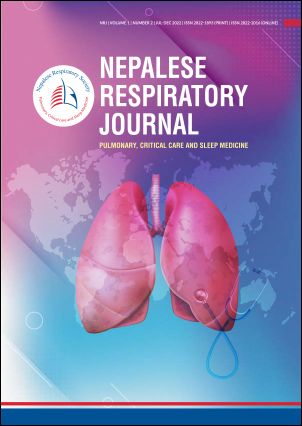Study of Point of Care Lung Ultrasound in Patients with Acute Respiratory Failure
DOI:
https://doi.org/10.3126/nrj.v1i2.54903Keywords:
COPD/Asthma, Dyspnea, PLAPS, Pneumonia, POCUSAbstract
Introduction: An acute dyspnea has been a common cause of hospital admission throughout history. When formulating a treatment plan based on limited clinical information, a rapid diagnosis is important. Bedside maneuvers and tests that deliver rapid and reliable results represent a cornerstone of diagnostics medicine.
Methods: This was a one-year cross-sectional research conducted at Chitwan Medical College Teaching Hospital. Consecutive patients with acute dyspnea whom were admitted for ≤ 6 hours were included in the study. A 5MHz micro-convex probe was used as the optimal single probe. Data entry and descriptive analysis were done in IBM SPSS version 20.0. Point estimate at 95% confidence interval was calculated along with frequency and descriptive statics.
Results: Pneumonia was the most common overall ultrasound diagnosis with combined frequency of 47%. With a Positive Predictive Value of 94.11% and Negative Predictive Value of 97.01%, anterior pneumonia exhibited a sensitivity of 94.11% and specificity of 97.11%. Similarly, Posterior Lateral Alveolar Points (PLAPS) pneumonia had a sensitivity of 94.11% and specificity of 98.08%, with a PPV of 94.11% and NPV of 98.80% respectively. The clinical accuracy for pulmonary edema was the greatest with 96.77%. while COPD/asthma had least accuracy with 81.25%.
Conclusions: POCUS of the lung, has a high sensitivity and specificity, especially for evaluation of acute causes of dyspnea such pulmonary edema and pneumonia. It is more sensitive than Chest X ray alone and should be integrated while making clinical diagnosis.
Downloads
Downloads
Published
How to Cite
Issue
Section
License
© Nepalese Respiratory Society

This article is licensed under a Creative Commons Attribution 4.0 International License.




